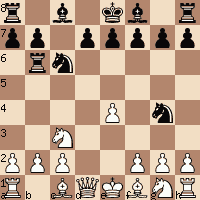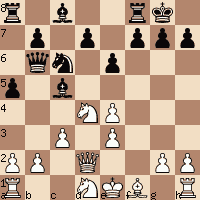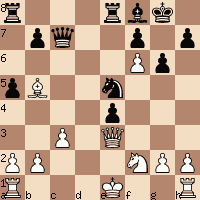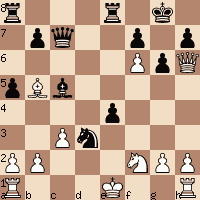1.e4 c5 2.Nf3 Nc6 3.d4 cxd4 4.Nxd4 Qb6 5.Ne2
My opponent played this move very quickly. After the game, he told me that he “just recently started experimenting with new lines against the Sicilian.” Unfortunately, a casual attitude like that towards the Sicilian Defense will often lead to disaster.
I quickly gained an advantage in this contest, and worked hard to convert it into a win. So this is the second article in this series called “How to Exploit Your Opponent’s Inaccuracies in the Opening.” You can read the previous article here.
Recommendation for White: Don’t play the Open Sicilian
If the main reason you play chess is because you want to have fun, then just play the openings you find interesting and exciting. In that case, the Open Sicilian will keep you entertained for several lifetimes.
On the other hand, if you’re serious about wanting to improve, then developing an opening repertoire will become an important part of your campaign.
In that case, I strongly recommend against playing the Open Sicilian (2.Nf3 followed by 3.d4), unless you want to spend countless hours learning variations, and the ideas behind them.
The other reason is …
At any level below 2400, other lines offer equal opportunity for advantage, without the incredible investment of time and energy demanded by the Open Sicilian.
It’s all about how much you want to improve, the time you want to spend studying chess, and the return on your investment.
I know from firsthand experience. I have bought the best books and spent many hours learning variations and all the ideas that apply:
The many different Sicilians
- Najdorf
- Classical
- Dragon
- Accelerated Dragon
- Kan
- Kalishnikov
- Two Knights
- Taimonov
- Pelican
- OKelly
Each one of those openings has numerous subvariations, and the ideas vary greatly from one to the next. After many hours of navigating these treacherous waters, I have returned to playing the Grand Prix.
Bottom line: if you want to become good at each one of these diverse Sicilians, you will have to achieve several goals.
Requirements to Play the Open Sicilian
- Spend many hours learning theory.
- Hope you remember what you learned against a live opponent.
- Realize there is no guarantee you will ever play the opening especially well or even get an advantage. That applies more in the Sicilian than other openings, for two reasons:
- Sicilian players are often fanatical, and they have usually spent many hours learning their pet lines.
- The Sicilian is the sharpest of all openings, and that means White’s mistakes get punished more severely than usual.
Coming Soon
In an upcoming series of articles, I will teach you many secrets about the Grand Prix Attack. It’s played by a large number of grandmasters, and leads to exciting positions. Most important of all, you will be able to play this opening at a high level, and reduce the amount of time you have to invest into learning theory by over 95%.
5...Nf6 6.Nbc3
Ng3 was superior. However, at that point White has spent three moves to post the knight on a bad square, and Black is completely equal, and probably better.

7.Be3 Nxe3 8.fxe3 e6
But not 8...Qxe3 9.Nd5 followed by 10.Nc7 check.
Know when to Analyze
I could have played 8...Qxb2, and after running that move through the computer, it turns out that with best play it leads to a larger advantage than I achieved in the game. The good news is that I didn’t spend any time at all analyzing this move.
Here are the reasons:
- The analysis would have been time consuming.
- My opponent would probably take over the initiative.
- He would also get a development advantage.
- I already have a large strategic advantage. I didn’t feel compelled to convert it so early in the game.
- After spending several minutes analyzing the capture, in the end I may have decided it was best to do something else
Thirty years of tournament play have taught me that sometimes it’s not worth analyzing certain moves. As you get stronger, you will begin to develop a sixth sense about when to analyze, and when to simply continue with clear logical moves.
Now if I was over 2400, then I would have analyzed the move. That’s because at that level, I would have more faith in (a) the precision of my analysis, and (b) my ability to “absorb the recoil effect” that often occurs after spending valuable time chasing pawns.
9.Qd2 9...Bc5
Committal Moves
Some moves irreversibly change the nature of the play, and entire direction of the game. The move 9…Bc5 was one of them. It was a very difficult decision, so I spent over 15 minutes on this move.
Tradeoff Analysis of 9…Bc5
Pros
- Strong developing move.
- Forces my opponent down a narrow path.
- The natural way to build upon my pressure on the dark squares.
- Note: There’s two great articles on the site where we discuss playing against a “color complex” (grandmasters’ term for focused play against either the light or dark squares).
Cons
- Allows
10. Na4, which leads to an ending I wasn’t completely certain I was winning. If I was unable to grind out a win, it would mean I attempted to convert my advantage prematurely.
I win a pawn in this variation, but the question becomes, “how valuable is my pawn advantage?” Here’s how I summed up the imbalances in that ending as I worked through specific variations:
Endgame Evaluation
- I end up with double isolated
bpawns. - I have a backward
dpawn. - I don’t see a clear way to create a pawn majority.
- White’s
epawn is weak. - I have a great post for my knight on
e5.
These are the key elements I identified in the position, and my final assessment was unclear. However, after a great deal of thought, I decided it was the best move.
My final thought was, “Well, if he wants to enter this ending, I’m better, and will capture at least a half point, and maybe the full point. That means I’ll be playing for a win without any risk.“
10.Nd1
After 10.Na4, the first three moves are forced for each side, and play would have continued something like this:
10.Na4 Bxe3 11.Nxb6 Bxd2+ 12.Kxd2 axb6 13.Nc3 d6 14.Rd1 Ne5 15.Ke3 Ke7 16.Be2 Bd7 17.Rd4 Bc6 18.Rhd1 Rhd8 19.a3 f6 20.h3 h6 21.g3 Ra5
The computer says Black has a half pawn advantage, but the win is a long way off. The move 9…Be7 is ranked only .06 less than 9…Bc5. In computer terms .06 means 6/100ths of a pawn.
Looking at the position from the point of view of my own style and personal preferences, if I had this position again, I would play 9…Be7.
In that line, surely my opponent would have many more unusual and difficult problems to solve in the middlegame. Not only that, my creativity and problem solving skills make me stronger in the middlegame (compared to the ending, which is often pure calculation).
10...0-0 11.c3 a5
This move stops b4, and maintains the bishop on its active diagonal, where it creates intense pressure on the dark squares.
When you’re attacking, it’s often important to take time out to secure the position of your pieces when they are posted on active squares.
12.Nd4 e5

This was another tough choice, and I spent at least 10 minutes here. First of all, let’s look at a powerful guideline.
Tradeoff Analysis: Structural vs Activity Advantage
The square directly in front of a pair of isolated doubled pawns is a tremendous post for a piece, especially the knight.
The advantage of 12…Ne5 is clear – it’s a beautiful post for the knight.
On the other hand, what happens after the knight occupies that square? It’s not so easy to make progress.
White’s knight on d4 holds his position together, and shields his weakness on e3. If I allow it to remain on d4, than both my bishop and queen are neutralized, and it’s not clear how to proceed.
Transformation of Advantages
So I played ...e5, and was pretty sure he would move to f5, even though I thought Nf3 was slightly better. The computer verified that intuition.
Look for a way to convert existing advantages into new advantages.
I had variations prepared for either move, but the most interesting possibility is 13.Nf5, and that’s what he played in the game.
Here’s the essence of my evaluation when I made the move:
“Since White’s king is stranded in the center, and my pieces are better, I’m going to trade my structural advantage for an activity advantage, and look hard for tactics over the next 10-15 moves, because assuredly some will arise.”
The Nature of Computer Evaluations
The computer evaluates 12…Ne5 as ¼ pawn better than 12…e5, and there’s a good chance it’s right.
However, it’s good to realize that computer assessments are not infallible. I’ve noticed many times that I play down the recommended path, and the evaluation either shrinks or grows radically over the next several moves.
Does that mean the computer’s initial evaluation was wrong?
Sometimes the answer is “yes.” But if you give the CPU enough time to work on a position, it will usually come pretty close to an accurate evaluation.
Here’s a scenario. Let’s say the computer assigns our position a “half pawn advantage.”
It’s good to realize that not all half pawns are created equal. Some are dissipative in nature, because there aren’t enough resources in the position to build upon the existing advantage, and convert it into a win. That means the assessment gradually dwindles down to zero.
Other half pawn advantages grow incrementally with the best moves. The half pawn provides leverage into every variation, the opponent is forced to make further concessions, and eventually the full point comes into sight.
13.Nf5 d5 14.Qxd5
It was important to analyze 14.exd5 Bxf5 15.dxc6 Qxc6.
In this variation, I have increased my development advantage, and am about to control the d file with a rook, attacking his queen at the same time. This was the endpoint of my analysis, and I liked how it felt.
14...Bxf5 15.exf5 Bxe3
Trading my dark square pressure for a new advantage. This final move represents the last move in my analysis, and now we’re looking at the new “activity advantage” that I created from his doubled e pawns (structural advantage).
16.Qf3
Surprises and Unintended Consequences
Even at the highest level of chess, players come to the end of a variation they’ve analyzed, and something appears on the board they don’t like, and did not anticipate.
This is a key moment in the game, and it’s vital to become calm and objective when this happens. Close your eyes, and take a few deep breaths, or find another way to center yourself.
Once you’ve achieved a calm state of mind, spend some time breaking down the position, assess piece activity and square weaknesses for both sides, to make sure you understand exactly what’s happening.
The Power of a Double Attack
When 16.Qf3 appeared on the board, I suddenly realized it involved a “double attack,” because (a) my bishop is attacked twice, and (b) 17.f6 is threatened, giving White counter play against my king and creating mate threats against g7.
Seek to Maintain the Initiative
I had to decide between Bc5 and Bg4. Each move has its advantages. 17...Bg4 holds the f6 square … but allows 18.Qf2! which is a very strong move, because it allows White to castle kingside after 19.Bd3.
I have a strong initiative in this position. A big part of it is because White’s king has trouble finding a home.
So that means I spent all my time analyzing 17...Bc5 18.f6. As long as I liked the solution, it was the path I would take.
16...Bc5 17.f6 g6
Computer Chess Analysis Compared to the Real World
The computer calls this position approximately equal. However, in the real world, in a fight between players of equal strength, Black would probably win this contest over 75% of the time.
Why do I feel Black’s position is so much better?
It’s because he has many different ideas, and many ways to improve his position. White’s only idea is to deliver checkmate on g7 (h4-h5 is too slow).
Although White’s threat against g7 is very strong, once Black creates a defense, he should be able to build a large advantage, based upon (a) his development and activity advantage, and (b) the position of White’s King stranded in the center.
18.Bc4 e4
Played to clear e5 for the knight, which will also attack the bishop when it lands on that square.
19.Qf4 Rfe8 20.Qh6 Bf8
More Unintended Consequences
When we reached this position, I immediately noticed that White can now play Bxf7, followed by Qxh7 check. This would send my king running through the center of the board.
In the process, White would also win my g pawn with check, and create a well advanced f pawn that was free to attack my rook.
Although it’s very unpleasant for Black to get forced down this path, fortunately, he is still winning in the end.
Only the exact configuration of the pieces on the board will determine whether an idea is successful
If all of White’s forces were developed, and his king was not stuck in the center, I would probably be losing after 21.Bxf7+.
Over time you will develop a sixth sense about when ideas work, and when they don’t. For now, just remember that each idea needs the right set of conditions to be successful.
21.Qe3
My opponent played this move in less than one minute. Certainly 21. Bxf7 was worth analyzing! It presents a wonderful opportunity that comes within a hair’s breadth of working.
21.Bxf7+ Kxf7 22.Qxh7+ Ke6 23.f7 Re7 24.Qxg6+ Kd7
and it’s not pretty, but in the end, Black is winning.
21...Qc7 22.Nf2 Ne5
And now it’s my turn to lose an opportunity. The move 22...Nb4 was much stronger, and wins very quickly. The key point is that it takes advantage of all the unique elements in the position (White’s stranded king, his loose bishop on c4, and the fork on c2). There was no adequate defense.
Natural Moves aren’t Always Best
So why did I miss 22...Nb4? In the past, I’ve found much more difficult moves that involved a great deal more analysis.
There are three reasons I missed this decisive move:
- I didn’t even look at it.
- I had planned for
...Ne5when I played...e4, so my mind was fixated on that square. Ne5was the natural move.
Often times we lose valuable opportunities when we make “the natural move” without thinking.
On the other hand, “natural moves” are probably best 70 to 80% of the time. That means they save us time on the clock and mental energy when we make them quickly, and they fit the requirements of the position.
So that means it comes down to having a good instinct about when and how deep to analyze.
In a future article, we will give you a 30 Second Quick Question Checklist. Questions are the answer, because the questions you ask direct your analysis. They determine what you look at.This checklist will help you move quickly and know when to analyze.
For right now we’ll give you one of our best Wisdom Keys: “Spend more time looking for alternatives when the position is dynamic and imbalanced.”
That’s exactly the kind of position we have right now. And that’s why “the unnatural knight move” worked so well.
22…Nb4 23.Bb3 23…Nd3+ 24.Kf1 Rad8 winning
23.Bb5

Defeat Confusion with Priorities
Spend more time looking for alternatives when the position is dynamic and imbalanced.
I was getting confused as I analyzed the possibilities, and I’ve noticed before this often means I’m missing something. Unfortunately, confusion happens at the board to every player from time to time.
That means it’s good to have a strategy to defeat confusion.
So over the years, I’ve developed criteria that help me prioritize the importance of what’s happening on the board, and this often helps guide me to the best move:
Priorities that help you find the right path
- Safeguard your king
- Lock in a material gain.
- Strengthen the center
- Maintain the initiative.
23...Re6
Here’s a fun variation: 23...Bc5 24.Qh6 Bxf2+ (with a knight fork on g4) 25.Kf1 and Black can’t prevent mate.
And here’s a very beautiful variation that also begins with 23…Bc5.
23…Bc5 24.Qh6 Nd3+ 25.Nxd3 exd3 26.Kd1 (White gets mated after 26.Bxe8 Qe4+) Bf8 27.Qh3 Qb6 28.Bxe8 Qxb2
Unfortunately, these ideas did not occur to me. However, that’s why I’m not rated over 2400. A high percentage of players under 2400 would have missed this exciting variation. Why? Not because it’s long and complicated. The average master can calculate more deeply than this. No, that’s not it. The reason they would not have collected the brilliancy prize is because the variation is filled with anomalies that resist analysis.
- The bishop goes to
c5, then back tof8again. - The rook is left hanging for more than one move,
- and even though it’s the piece that delivers check, it still cannot be captured.
It takes a very sharp and agile mind to put together these ideas. In case you didn’t play through those moves, let’s look at the position at the exact moment the board reached full intensity.

24.0-0-0 a4 25.Nxe4
After 25.a3 I was thinking it was no longer clear I had an advantage, and the computer verifies the game would have been about equal if White had played this vital move.
25...a3
This move pulverizes White’s king safety, in much the same way that termites chew up the foundation of a building.
The threats against c3 now become very powerful. That’s why it was so important for White to play a3.
26.b3 Ng4
Combining the pin on the knight with threats against the king. The position is now decisive.
27.Qd4
I saw that I could win the exchange after this move by checking on f4. Let’s see what would have happened if White had played Qf3 to hold the f4 square.
27.Qf3 Rxe4 28.Qxe4 Qxc3+ 29.Qc2 Qa1+ 30.Qb1 Bh6+ 31.Kc2 Ne3+ 32.Kd3 Qe5
and White’s King is hopelessly entangled in the mass of Black pieces.
Important note: In this king hunt variation, 32…Qe5 is decisive and much better than …Rd8+, which causes vital material to come off the board. When you’re attacking don’t just check the king unless you see a good continuation. It’s often better to keep it boxed in, bring in new pieces, or cut off escape squares.
27...Qf4+
If you see a move that’s clearly and easily winning, just play it right away. Don’t bother looking for something better.
Question:
So why didn’t I play 27…Rxe4+ followed by Qxc3, entering the variation we just examined?
Answer:
Because I didn’t bother to analyze that variation!
It’s tricky and involves a lot of calculation. I was low on time, and winning the exchange was simple and clear. Here’s a quote from Kasparov:
“If you see a move that’s clearly and easily winning, just play it right away. Don’t bother looking for something better.“
28.Nd2 Qxd4 29.cxd4 Nf2 30.Bc4 Rc6 31.d5 Rc7 32.Rhf1 Nxd1 33.Kxd1
Rook vs Bishop and Pawn Ending
We’ve now entered this endgame, and it’s important to know that a rook vs a bishop and pawn isn’t always winning. One of the biggest keys that determines the outcome is whether the pawn is far advanced and well protected.
Of course the position of each king and all the pieces also plays a huge role in the evaluation. I knew I was easily winning this position because (a) the rooks have good lines, and (b) his king will get caught in the crossfire.
33...Rd8 34.Ne4 b5 35.Be2 Rxd5+ 36.Ke1 Rc1+ 37.Kf2 Rc2 resigns.
We covered a lot in this article.
It contains somewhere between 3-4 times the content of “regular chess articles” that you’ll find on most websites. So let’s quickly put together an outline of all we touched upon:
Summary of Article
- Recommendation for White: Don’t play the Open Sicilian
- The many different Sicilians
- Requirements to Play the Open Sicilian
- Know when to Analyze
- Committal Moves
- Tradeoff Analysis: Endgame vs Middlegame
- Pros
- Cons
- Endgame Evaluation
- Advantages
- Tradeoff Analysis: Structural vs activity advantage
- Transformation of Advantages
- The Nature of Computer Evaluations
- Surprises and Unintended Consequences
- The Power of a Double Attack
- Seek to Maintain the Initiative
- Computer Analysis Compared to the Real World
- Natural Moves aren’t Always Best
- Priorities
- Defeat Confusion with Priorities
- Priorities that help you find the right path
- Rook vs Bishop and Pawn Endings
We’re very interested in your feedback.
Some people say you have to “keep your articles short, because most people’s attention span is so limited.” We feel that’s true for most people, but not chess players.
Chess players think way deeper than average. Your concentration and attention span are much greater, and we know that’s a big part of why you love the game.
On the other hand, just let us know if you’d like us to trim down these thought provoking articles. Our mission: give you what you like the most that helps you improve the fastest.

THAT IS TRICKEY
I just started playing again recently and Im not a very advanced player. (Still not familiar with chess notation very much). As far as feedback goes though, I just want to say, I found this article (as well as several others that I’ve come across to be incredibly confusing). One seemingly simple solution could be that all the abundant right hand margin white space could be put to good use with more labeled pictures of the actual board (and not just chess notation) to help make clear the flow of the game (as it is referred to in the post). Unfortunately, the last board picture in this post adds to that confusion though because it says black delivers checkmate on C2, but after spending 20 minutes looking at the picture of that board, I couldn’t for the life of me figure out HOW or by who that happens. I doubt it was a typo, but the apparent gap or missing board picture to clarify how it happens doesn’t help.
Basically, if you’re looking at making these posts clearer, more helpful, and perhaps even more popular, making them more accessible to the “Cory’s” and “Deon’s” out there that might be just starting out will probably help. (Another REALLY cool, but possibly too difficult option (I’m not familiar with programming) is having a small program or addition to SparkChess that allows you to enter the game into the program and follow along with the essay).
Thanks,
Kamarazov